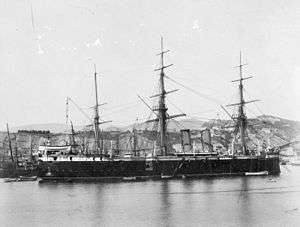HMS Superb (1875)
 HMS Superb (IWM Q674444) | |
| History | |
|---|---|
| Name: | HMS Superb |
| Builder: | Thames Ironworks and Shipbuilding Company, Leamouth, London |
| Laid down: | 1873 |
| Launched: | 16 November 1875 |
| Completed: | 15 November 1880 |
| Commissioned: | 4 October 1880 |
| Fate: | Broken up 1906 |
| General characteristics | |
| Displacement: | 9,710 tons |
| Length: | 332 ft 4 in (101.30 m) |
| Beam: | 59 ft (18 m) |
| Draught: |
|
| Propulsion: |
|
| Sail plan: | Barque rig |
| Speed: | 13.2 kn (24.4 km/h) (under power) |
| Complement: | 654 |
| Armament: |
|
| Armour: |
|
HMS Superb was an ironclad battleship designed by Sir Edward Reed for the Ottoman Navy, and was built in Britain by Thames Ironworks under the name of Hamidieh. She had both engines and sails.
Together with the two ships of the Belleisle class and HMS Neptune, she was compulsorily purchased by the British Government at the time of the Russian war scare of 1878. Her original design drawings show her as an enlarged Hercules with heavier armament and thicker armour; she was extensively altered from these plans after her purchase, leading to a five-year gap between her launch and her completion. Her poop and forecastle were enlarged, enabling her to carry sixteen ten-inch muzzle-loaders. This was the highest number of heavy guns of uniform calibre ever carried on a British battleship. She also received searchlights, torpedo discharge equipment, extra coal bunkers and extra cabins.
In her original design, the mess-deck was unusually lofty. In her conversion an extra deck was added about five feet below the beams, to be used for slinging hammocks. It was always known as the "slave deck".
Although Superb was intended to be able to proceed under sail, and was barque-rigged to this end, it was found that she was unmanageable without power, so no sailing statistics were ever elicited.
She had a sister-ship, the Mesudiye, which was commissioned by the Ottoman navy as planned.
Service history
She commissioned at Chatham for service in the Mediterranean on 4 October 1880, and remained on station for seven years. She took part in the bombardment of Alexandria, where she fired 310 shells of 10-inch calibre at the Egyptian forts; she received ten hits in return, seven of them on her armour, with no casualties. After reconstruction at Chatham from 1887 to 1891 she was guard ship on the Clyde until 1894, when she paid off into Fleet Reserve. Her only other sea time was at the time of the manoeuvres of 1900. In 1904 she was used as a hospital overflow ship for infectious cases, until she was sold in 1906.
References
- Colledge, J. J.; Warlow, Ben (2006) [1969]. Ships of the Royal Navy: The Complete Record of all Fighting Ships of the Royal Navy (Rev. ed.). London: Chatham Publishing. ISBN 978-1-86176-281-8. OCLC 67375475.
- Oscar Parkes, British Battleships ISBN 0-85052-604-3
- Conway, All the World's Fighting Ships ISBN 0-85177-133-5
- D K Brown, Warrior to Dreadnought ISBN 1-86176-022-1